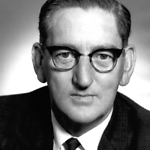Person
Dick, Alexander Thomas (1911 - 1982)
FAA

Alexander Thomas Dick
Details
- Born
- 9 February 1911
Melbourne, Victoria, Australia - Died
- 3 July 1982
- Occupation
- Biochemist
Summary
Alexander Dick was Chief, CSIRO Division of Nutritional Biochemistry 1965-1976. His discovery of the metabolic interrelation of molybdenum, copper and sulphate led a number of overseas scientists to study trace element nutrition involving mineral interrelations. He also undertook intensive study into the chemistry of the pyrrolizidine alkaloids and their mode of action in giving rise to liver damage, particularly in ruminants.
Details
Born Melbourne, 9 February 1911. Died Adelaide, 3 July 1982. OBE 1965. Educated Melbourne Technical College (Public Analyst Certificate 1929) and University of Melbourne (BSc 1932, DSc 1954). 'Chemical cadet', Mount Lyell Chemical Works 1928-29; assistant to the works manager and chief chemist, Francis Longmore and Co. 1929; Junior Research Officer, Council for Scientific and Industrial Research Animal Health Research Station, Townsville 1933-37, with technical and administrative responsibility for the 'Helenslee' field station and administrative responsibility for the research station from 1936; Officer-in-charge, Chemical Pathology Section, CSIR Division of Animal Health and Production 1938-65; Chief, CSIRO Division of Nutritional Biochemistry 1965-76. David Syme Research Prize (shared), University of Melbourne 1954; Fellow, Australian Academy of Science 1964. Fellow, Royal Australian Chemical Institute 1952; sometime president and honorary life member, Australian Society of Laboratory Technology; foundation member and 1958 president, Victorian Society of Pathology and Experimental Medicine.
Chronology
- 1952 - 1953
- Award - Fellow, Australian Chemical Institute
- 1953 - 1982
- Award - Fellow, Royal Australian Chemical Institute
- 1954
- Award - David Syme Research Prize (jointly), University of Melbourne
Related entries
Published resources
Journal Articles
- Price, J. R., 'Alexander Thomas Dick 1911-1982', Historical Records of Australian Science, 6 (3) (1986), 393-397. https://doi.org/10.1071/HR9860630393. Details
Resources
- Wikidata, http://www.wikidata.org/entity/Q66736076. Details
- 'Dick, A T (1911-1982)', Trove, National Library of Australia, 2009, https://nla.gov.au/nla.party-807820. Details
Resource Sections
- Price, J. R., 'Alexander Thomas Dick 1911-1982', in Australian Academy of Science Biographical Memoirs, Australian Academy of Science, 1986, https://www.science.org.au/fellowship/fellows/biographical-memoirs/alexander-thomas-dick-1911-1982. Details
- Ward, C., 'Alexander Thomas (Alick) Dick', in CSIROpedia, Commonwealth Scientific and Industrial Research Organisation (CSIRO), 2011, https://csiropedia.csiro.au/Dick-Alexander-Thomas. Details
See also
- French, E. L.; and Stewart, D.F., 'Lionel Bately Bull, 1889-1978', Historical Records of Australian Science, 5 (4) (1983), 90-110. https://doi.org/10.1071/HR9830540090. Details
- French, E. L.; and Sutherland, A. K., 'Arthur William Turner 1900-1989', Historical Records of Australian Science, 9 (1) (1992), 49-63. https://doi.org/10.1071/HR9920910049. Details
Digital resources
Rosanne Walker
Created: 20 October 1993, Last modified: 4 June 2010
- Foundation Supporter - Committee to Review Australian Studies in Tertiary Education
